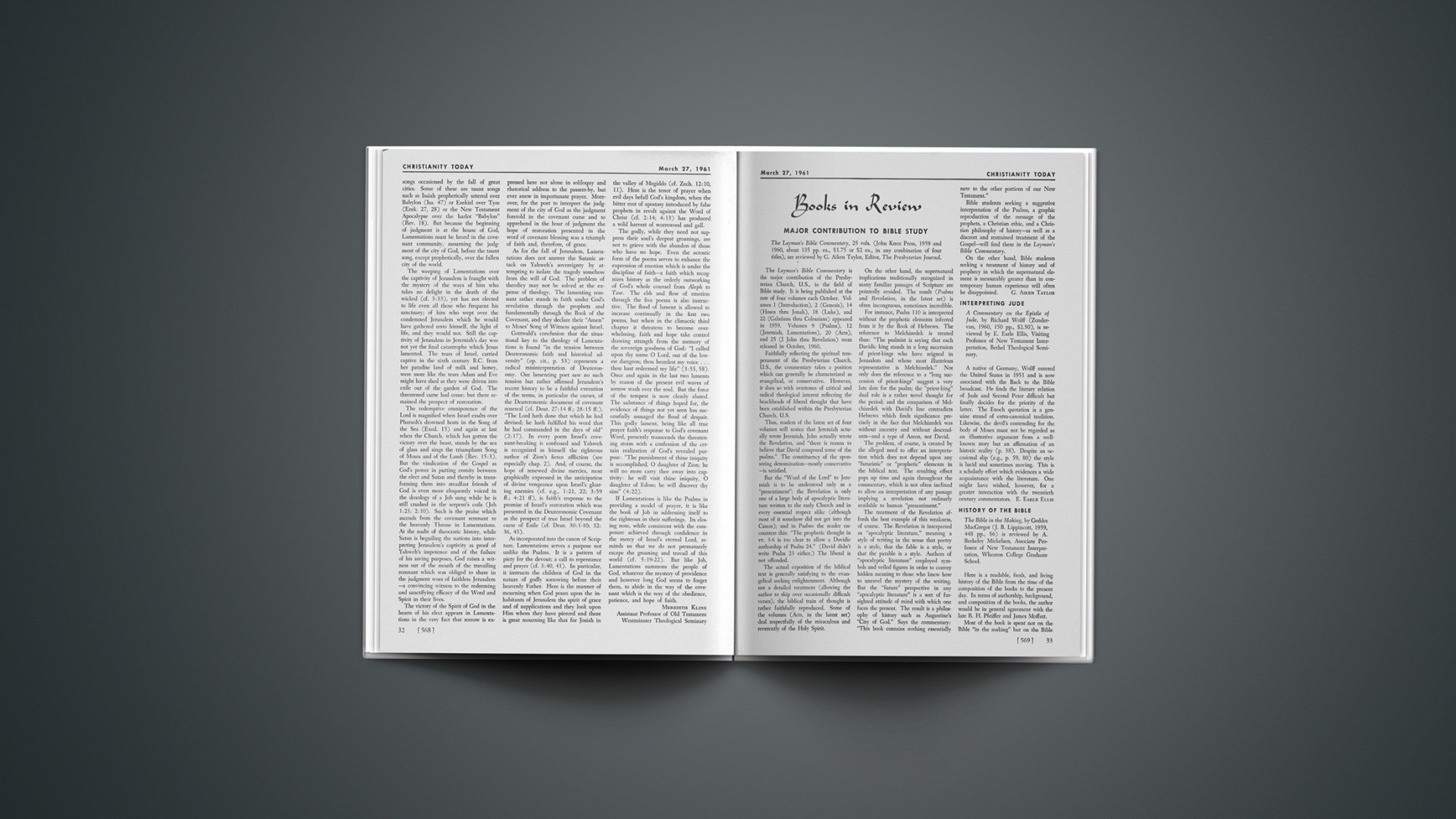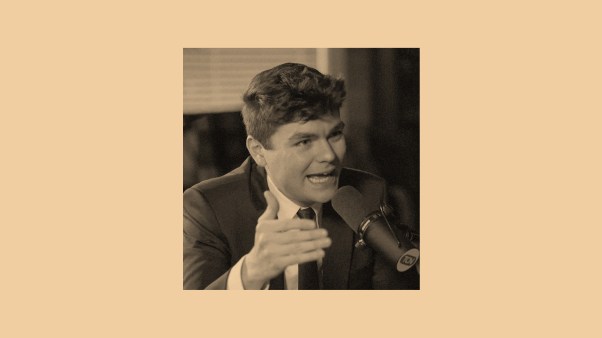Major Contribution To Bible Study
The Layman’s Bible Commentary, 25 vols. (John Knox Press, 1959 and 1960, about 135 pp. ea., $1.75 or $2 ea., in any combination of four titles), are reviewed by G. Aiken Taylor, Editor, The Presbyterian Journal.
The Layman’s Bible Commentary is the major contribution of the Presbyterian Church, U.S., to the field of Bible study. It is being published at the rate of four volumes each October. Volumes 1 (Introduction), 2 (Genesis), 14 (Hosea thru Jonah), 18 (Luke), and 22 (Galatians thru Colossians) appeared in 1959. Volumes 9 (Psalms), 12 (Jeremiah, Lamentations), 20 (Acts), and 25 (I John thru Revelation) were released in October, 1960.
Faithfully reflecting the spiritual temperament of the Presbyterian Church, U.S., the commentary takes a position which can generally be characterized as evangelical, or conservative. However, it does so with overtones of critical and radical theological interest reflecting the beachheads of liberal thought that have been established within the Presbyterian Church, U.S.
Thus, readers of the latest set of four volumes will notice that Jeremiah actually wrote Jeremiah, John actually wrote the Revelation, and “there is reason to believe that David composed some of the psalms.” The constituency of the sponsoring denomination—mostly conservative—is satisfied.
But the “Word of the Lord” to Jeremiah is to be understood only as a “presentiment”; the Revelation is only one of a large body of apocalyptic literature written to the early Church and in every essential respect alike (although most of it somehow did not get into the Canon); and in Psalms the reader encounters this: “The prophetic thought in vv. 3–6 is too clear to allow a Davidic authorship of Psalm 24.” (David didn’t write Psalm 23 either.) The liberal is not offended.
The actual exposition of the biblical text is generally satisfying to the evangelical seeking enlightenment. Although not a detailed treatment (allowing the author to skip over occasionally difficult verses), the biblical train of thought is rather faithfully reproduced. Some of the volumes (Acts, in the latest set) deal respectfully of the miraculous and reverently of the Holy Spirit.
On the other hand, the supernatural implications traditionally recognized in many familiar passages of Scripture are pointedly avoided. The result (Psalms and Revelation, in the latest set) is often incongruous, sometimes incredible.
For instance, Psalm 110 is interpreted without the prophetic elements inferred from it by the Book of Hebrews. The reference to Melchizedek is treated thus: “The psalmist is saying that each Davidic king stands in a long succession of priest-kings who have reigned in Jerusalem and whose most illustrious representative is Melchizedek.” Not only does the reference to a “long succession of priest-kings” suggest a very late date for the psalm; the “priest-king” dual role is a rather novel thought for the period; and the comparison of Melchizedek with David’s line contradicts Hebrews which finds significance precisely in the fact that Melchizedek was without ancestry and without descendants—and a type of Aaron, not David.
The problem, of course, is created by the alleged need to offer an interpretation which does not depend upon any “futuristic” or “prophetic” elements in the biblical text. The resulting effect pops up time and again throughout the commentary, which is not often inclined to allow an interpretation of any passage implying a revelation not ordinarly available to human “presentiment.”
The treatment of the Revelation affords the best example of this weakness, of course. The Revelation is interpreted as “apocalyptic literature,” meaning a style of writing in the sense that poetry is a style, that the fable is a style, or that the parable is a style. Authors of “apocalyptic literature” employed symbols and veiled figures in order to convey hidden meaning to those who knew how to unravel the mystery of the writing. But the “future” perspective in any “apocalyptic literature” is a sort of farsighted attitude of mind with which one faces the present. The result is a philosophy of history such as Augustine’s “City of God.” Says the commentary: “This book contains nothing essentially new to the other portions of our New Testament.”
Bible students seeking a suggestive interpretation of the Psalms, a graphic reproduction of the message of the prophets, a Christian ethic, and a Christian philosophy of history—as well as a discreet and restrained treatment of the Gospel—will find these in the Layman’s Bible Commentary.
On the other hand, Bible students seeking a treatment of history and of prophecy in which the supernatural element is measurably greater than in contemporary human experience will often be disappointed.
G. AIKEN TAYLOR
Interpreting Jude
A Commentary on the Epistle of Jude, by Richard Wolff (Zondervan, 1960, 150 pp., $2.50), is reviewed by E. Earle Ellis, Visiting Professor of New Testament Interpretation, Bethel Theological Seminary.
A native of Germany, Wolff entered the United States in 1951 and is now associated with the Back to the Bible broadcast. He finds the literary relation of Jude and Second Peter difficult but finally decides for the priority of the latter. The Enoch quotation is a genuine strand of extra-canonical tradition. Likewise, the devil’s contending for the body of Moses must not be regarded as an illustrative argument from a well-known story but an affirmation of an historic reality (p. 38). Despite an occasional slip (e.g., p. 59, 80) the style is lucid and sometimes moving. This is a scholarly effort which evidences a wide acquaintance with the literature. One might have wished, however, for a greater interaction with the twentieth century commentators.
E. EARLE ELLIS
History Of The Bible
The Bible in the Making, by Geddes MacGregor (J. B. Lippincott, 1959, 448 pp., $6) is reviewed by A. Berkeley Mickelsen, Associate Professor of New Testament Interpretation, Wheaton College Graduate School.
Here is a readable, fresh, and living history of the Bible from the time of the composition of the books to the present day. In terms of authorship, background, and composition of the books, the author would be in general agreement with the late R. H. Pfeiffer and James Moffatt.
Most of the book is spent not on the Bible “in the making” but on the Bible in the historical process of being copied and disseminated. The Bible before the age of printing and from Gutenberg to the present occupies the author’s attention. No aspect is neglected. Four chapters are devoted to the King James Version. Particularly outstanding is chapter 13, “The King James Version in Production,” and chapter 12, “The Makers of the King James Version.” What people do not know about the King James Version is astonishing. In an admirable way, MacGregor removes such ignorance with fact coupled with human interest.
The book has 14 appendices. These alone are worth the price of the book. Appendix III is superb: “Modern Languages into which the Bible Has Been Translated (pp. 331–383). The history of the Bible is inherently a fascinating theme. MacGregor’s The Bible in the Making has made actual what was inherently potential.
A. BERKELEY MICKELSON
Dark Atomic Age
The Future of Mankind, by Karl Jaspers, translated from the German by E. B. Ashton (University of Chicago Press, 1961, 342 pp., $5.95), is reviewed by C. Gregg Singer, Professor of History, Catawba College.
This is a book that should be read by every liberal who has lost contact with the grim reality of an atomic age, and does not see the crisis which the West faces, and by every evangelical who seeks to keep abreast of the intellectual trends of the day. The liberal will be brought face to face with the utter shallowness of the basic assumptions of that liberalism with which he has been blinded, and the utter futility of his optimistic view of man in belief and progress as it is usually defined. On the other hand, the evangelical will gain a new insight into the stark pessimism which threatens to overwhelm the modern mind.
Writing against a backdrop of the very real possibility of atomic warfare, and his belief that such a conflict would bring only complete ruin to civilization as we know it, and perhaps, the extinction of the race, Karl Jaspers examines the usually accepted proposals for averting such catastrophe and finds them all insufficient in that they offer little or no hope to modern man. His criticisms are marked with great insight and keenness and in these chapters he is at his best. He finds the commonly accepted idea of the soldier and warfare of the past as totally inadequate in the present emergency. In his discussion of neutrality (not to be confused with political neutralism), he recognizes that it can no longer retain its old meaning which it still possessed as late as 1914. “Neutrality means the self-preservation of freedom, and the mere existence of such a political condition irritated totalitarianism” (p. 138). This new neutrality must arm for its own defense, but at the same time such a neutral state “might come to symbolize the possibility of peace for all” (p. 139). But Jaspers does not indicate just how it might become such a symbol. Particularly pertinent in the light of the present situation are his comments on the United Nations. He insists that this organization “resembles a stage on which an incidental interlude is presented” (p. 155), while the great powers make their plans. “It is the sham communications in which they hide their purposes by placing themselves among some eighty major and minor states and recognizing the equality of all” (p. 155). He feels that the United Nations Organization offers little or no hope for permanent peace and should not be relied upon to any great extent. “The UN of today is the ambiguous structure that promotes chaos and wants to bring order out of it at the same time” (p. 159).
Jaspers, almost overwhelmed by the enormity of the crisis confronting humanity, is hard pressed to find a solution. Neither existing institutions, nor science or theology are adequate for the task. The future of mankind does not lie with either Christianity or the Church. They can help, but philosophy is needed, and he defines it as “the thinking that enables man to ascertain what exists and what he wants, to grasp his meaning and to find himself from the source” (p. 196). Thus, the only remedy to be found is an existential approach. There are frequent references to human freedom, which is never adequately defined, and to a rationalism which is existentialist in character. The book displays, with a dismaying clarity, the bankruptcy of “the post modern mind” as it staggers under the load of persistent problems for which it has no answers.
C. GREGG SINGER
Advice For Travelers
Assignment: Overseas, by John Rosengrant and others (Crowell, 1960, 152 pp., $1.95), is reviewed by L. Nelson Bell.
Every pastor should be aware of this book and see that a copy is placed in the hands of any of his parishioners who is to take up residence abroad.
There are Americans who give offense to peoples of lands they visit because they are themselves crude and indifferent to the feelings of others.
There are others who give offense through sheer ignorance of cultures, customs, and the mores in the lands to which they may be assigned. These people want to know how to meet new situations and are anxious to avoid the mistakes which make for resentment and misunderstanding.
Assignment: Overseas is a comprehensive book with a wealth of information and sound advice, written by a number of men with broad experience in the field about which they write.
Business firms with branch offices abroad; our own government with its multiplied representatives scattered around the world; the traveler; even the casual tourist would profit greatly to get this book and read it carefully before leaving our shores.
By so doing they can avoid embarrassment and misunderstanding and at the same time prove worthier representatives of the best America has to offer.
L. NELSON BELL
Spiritual Guidance
My Answer, by Billy Graham (Doubleday, 1960, 259 pp., $3.50), is reviewed by J. D. Grey, Pastor, First Baptist Church, New Orleans, Louisiana.
“Can you tell me this?” is the introductory statement of sincere appeals for help constantly heard by pastors, Christian workers, and others. In My Answer, Billy Graham answers hundreds of questions that have been propounded to him and answered by him over the years in his syndicated column carried by over 150 newspapers five days a week.
These questions show the perplexing problems people face today and the deep distress in which many of them find themselves. Out of his vast experience, study, and observation, Dr. Graham answers these questions in a sympathetic, warm-hearted, Bible-centered manner. The book will prove most helpful to people in all walks of life who have their own problems. It will also prove indispensable in its aid to ministers, teachers, counselors, and other Christians seeking to deal with the disturbed and perplexed soul of many who come to them for spiritual guidance. The great heart and compassionate, sympathetic, understanding spirit of the noted evangelist emerges in glorious fashion as spiritual guidance is given in My Answer.
J. D. GREY
Unique Apologetic
Symbolism in the Bible and in the Church, by Gilbert Cope (Philosophical Library, 1959, 276 pp., $10), is reviewed by Bernard Ramm, Professor of Systematic Theology, California Baptist Theological Seminary.
In the author’s own words, “The general thesis of this book is that the imagery and symbolism of the Bible and the Church are valid and effective still—perhaps even more so now than the rational analysis of human consciousness and natural environment has disclosed such a vast realm of mystery and ineffability” (p. 12). Later he discusses Jung’s theory of psychological archetypes and cites with favor an author who sees in these archetypes “an enormous inexhaustible store of ancient knowledge concerning the most profound relations between God, man, and the cosmos” (p. 87). Then the author says: “It is in this spirit that the remainder of this book is written. It is an attempt to apply some of these ideas to the study of the Scriptures and of Christian worship in the hope that we may be helped to find a way out of the present impasse in religion” (pp. 87–88).
The book is, then, a kind of apologetic, but a very unique one. The Bible is currently rejected by scholars, critics, and scientists, but if the symbols of the Bible are approached through our knowledge of symbolism gained from anthropological research, and if religious experience is interpreted through the Jungian archetypes, then Christianity will become relevant to modern man. This new apologetic must be concretely applied to church architecture.
The author is widely read in certain areas only, but he is very literate. We are taken upon an unusually odd, unusually bizarre, and exceedingly confusing ride. Apparently the only two options Cope reckons with are: (1) orthodoxy of all kinds which takes the teachings of the Bible literally and thus manages to make a supercolossal mess of it; and (2) a strange synthesis of typological hermeneutics of sorts, a theological symbolism derived from a rather extensive cultural survey of symbols, and Jungian psychological archetypes. One example of this bizarre procedure is that he can readily agree that Joseph is Jesus’ father, and that Mary is the holy virgin Mary. Biologically, Joseph is the father of Jesus; but in the rich symbolism of femininity Mary is to the Church the Great Mother and Holy Virgin! This interpretation of the Virgin Birth, Cope tells us, will offend strict orthodox people and atheists (p. 153).
There are three serious weaknesses to the work. First, it is personal to the finger tips. It makes for interesting, fascinating, and unusual reading in spots, but serious theological exposition must be more than a registry of highly personal opinions. Secondly, the root of the problem of the book is theological methodology. Before the author can meaningfully talk about symbolism, it seems to me he must first settle the big problems of theological methodology. He needs to spend many hours with such authors as Paterson, Brunner, Lecerf, Barth, Warfield, Kuyper, and Weber who debate the deep and profound issues in theological methodology. Without fundamental work in theological methodology, the theses of Cope really hang in mid-air.
Thirdly, such a work on symbolism can only come to maturity when it is further based upon studies in linguistics, semantics (the philosophy of language), and logic (the rules of thought). The book suffers immensely in the mind of this reviewer, from a real grounding in any of these three.
BERNARD RAMM
Survey Of Religions
Religions of the East, by Joseph M. Kitagawa (Westminster, 1960, 319 pp. $4.50), is reviewed by Samuel H. Moffett, Professor, Presbyterian Theological Seminary, Seoul, Korea.
This useful and informative survey could be called “The Doctrine of the Church in the Religions of the East.” Kitagawa, who is now at the University of Chicago, has focused short studies of Asia’s major faiths around their varying concepts of the “holy community”: Confucianism and the family, Hinduism and caste, Buddhism and the Samgha, Islam and the Ummah.
The ecclesiastical structures of Hinduism and Confucianism, he points out, are adaptations of already existing social units—family and caste. Buddhism, on the other hand (like Christianity), created its own. Its Samgha originally included laymen as well as priests but was gradually narrowed down to the monastic orders, and only in recent years has Buddhism’s “ecumenical movement,” as Kitagawa puts its, begun to “glimpse … the Samgha Universal in the midst of the brokenness of the empirical Buddhist Community.” The Ummah of Islam is both a holy community and a body politic, a theocratic state which had no priesthood or special holy community apart from society.
Contributing to the value of the studies is a short and useful historical sketch of each religion with special reference to its modern developments.
Comparisons of religion too often fail in their labored claims of likeness or uniqueness. A strength of Kitagawa’s work is that, except in an introductory chapter, he contents himself with description and analysis and avoids misleading comparisons to Christianity.
SAMUEL H. MOFFETT
Lion At Bay
In the Arena, by Isobel Kuhn (C.I.M., 1959, 192 pp., cloth 8s. 6d., paper 6s. 6d.), is reviewed by John Job, Lecturer, Rawdon Methodist College, Leeds, England.
The editor of a Christian magazine recently said he did not altogether blame his readers if they found missionary writing distasteful. That one can sympathize with such a remark is a sad reflection on the missionary works of the last few years. Everybody has noted that Isobel Kuhn’s books are like an oasis in a literary desert. What is it about them? The obvious thing is that they welcome the reader. They do not repel him by giving the impression that a first-class Christian is addressing second-raters in whom missionary interest is a wan and flickering light. They are written with an honesty and genuine humility that gives to the problems she faced in remote lands a spiritual proximity to those faced by the housewife at home. Physical hardship, separation from husband or child, and danger of war heighten the colors, but the underlying picture is the same.
This book is not only an instinctive account of a missionary’s life in China, but also the testimony of one who found that God’s Word was indeed a light unto her feet—even in the darkest corners.
JOHN JOB
Revival In Wales
When He is Come, by Eifion Evans (Evangelical Trust of Wales, 1959, 108 pp., 4s. 6d.), is reviewed by the Reverend J. Gwyn-Thomas, Rector of Illogan, Cornwall.
The centenary of the great religious movements of 1859 has inspired the writing of new books partly to commemorate those movements and partly because there is a turning to God for a fresh outpouring of his Spirit in view of our contemporary religious situation, as desperate a condition as ever was in the past century. Dr. Eifion Evans has placed us in his debt by giving us this valuable study of the situation in Wales during the years 1858–60. This small book is well documented, chiefly from contemporary periodicals and books. The most useful feature of the work it that it is written from a theological standpoint; we are given a glimpse of what was preached by the leaders of this movement of the Spirit. The emphasis is not on technique but on doctrine.
Moreover, interwoven with the factual accounts there runs a constant theme on the place of prayer in the life of the churches affected by the Revival. These two factors alone make this book both valuable and timely. We strongly recommend this work of Dr. Evans to all readers who are seeking a fresh outpouring of the spirit and to that end are concerned with breaking the soil.
JOHN GWYN-THOMAS
Evangelistic Preaching
The Rich Man and Lazarus, by Brownlow North (Banner of Truth, 1960, 125 pp., 2s.6d.), is reviewed by H. M. Carson, Vicar of St. Paul’s, Cambridge.
This exposition of the parable was originally delivered as a series of addresses in the open air during the 1859 revival in Northern Ireland. In view of the great blessing which attended the ministry of Brownlow North, they will repay study in a day far removed from that flood tide.
The parables are notoriously difficult to expound. Shall we insist on one central lesson or shall we indulge in excessive allegorizing? Christ’s own exegesis of the Sower would seem to point the way, for in it he combines the emphasis on the central theme, with an exposition of the details, all of which bear on the theme. Judged by this standard North’s exegesis would stand. It is true that he expounds in detail the story; but his detailed exposition constantly converges on the main word of warning. Of course North himself took it as history, though he does seem to leave the question an open one as to whether it is history or parable.
Throughout there runs a strong vein of warning together with an urgent call to repentance. It is powerful evangelistic preaching; and one is forced to ask if this preaching of hell is not one of the forgotten dimensions in contemporary preaching. In this, as in so many things, even evangelicals tend to feel that we are wiser than our fathers. But a glance at the state of the church today compared with 1859, or the eighteenth century, might lead to second thoughts on the matter.
H. M. CARSON
Triune Truth
Stand Up in Praise to God, by Paul S. Rees (Eerdmans, 1960, 117 pp., $2), is reviewed by Richard Allen Bodey, Pastor, Third Presbyterian Church, North Tonawanda, New York.
Here is proof that doctrinal preaching, even when soaring through the highest orbits of Christian truth, need not be dull, pedantic, or irrelevant. These ten messages by the former pastor of the First Covenant Church of Minneapolis, three on each Person of the Godhead, and one on the Trinity, will clarify difficult points for the laymen, and spur the preacher on to feeding his flock with the strong meat of the Word.
RICHARD ALLEN BODEY
Adventist Literature
The Seventh-day: The Story of the Seventh-day Adventists, by Booton Herndon (McGraw-Hill, 1960, 267 pp., $4.95), is reviewed by Walter R. Martin, Director, Christian Research Institute.
Following in the footsteps of its predecessor (Seventh-day Adventist—“Faith in Action,” by David Mitchell), The Seventh-day is a sympathetic portrait carrying the Nihil Obstat of the Adventist denomination. Advertisements for the book describe it as an “authorized” publication, so its goal at the outset is clear. Mr. Herndon is a non-Adventist, but the book is to all intents and purposes an Adventist book. It catalogs in narrative and travelogue form some of the admirable accomplishments of Adventist missionaries with a sprinkling of humor and an enthusiasm that is catching. The value underscores missions and the zeal of Adventists in propagating their beliefs. It is interesting and informative, but objectivity suffers greatly especially in the area of history and theology.
The general tenor of the book is best summed up in Mr. Herndon’s own words: “If … the primary desire … is security … then the Seventh-day Adventist must surely be content for his security is assured. They are as positive in their own minds as mortal men can be that, if they meet the conditions of personal righteousness, their lives not only extend to the grave, but far beyond it, forever and ever, in the steady and constant unimaginable joy.… In America at least, they contribute four times as much money to their church on a percapita basis than the national average of the other denominations.”
It is unfortunate that Mr. Herndon glosses over Ellen G. White and apparently was unaware of the fact that the very “reform dress” which she advocated and for which he lauds her was in reality a fiasco which exploded in her face and caused her no end of embarrassment. He also fails to mention Dr. Kellogg’s side of his disagreement with the Adventist church and Dr. Kellogg’s denouncement of James and Ellen White. These and other things make The Seventh-day an extremely one-sided volume.
In recent years the publishing field has been flooded with vanity books which capitalize upon a virtually captive audience (“The Cross and The Crown”—Christian Science; “Faith on the March” and “The New World Society”—Jehovah’s Witnesses; “Faith in Action”—Seventh-day Adventism). They provide a ready money market; and their sales are, to say the least, rewarding. Unfortunately they all betray a basic lack of research and acquaintance with primary data, and they are all notoriously prejudiced in favor of the subject.
The Seventh-day is also guilty of this in a lesser degree, although it must be viewed as propaganda for Seventh-day Adventism.
WALTER R. MARTIN
Book Briefs
Building a Christian Home, by Henry R. Brandt, and Homer E. Dowdy (Scripture Press, 1960, 158 pp., $3). A Christian “how” book written out of experience in scientific and practical marriage counselling.
Jesus Says to You, by Daniel A. Poling (McGraw-Hill, 1961, 119 pp., $2.95). 40 spirit-lifting devotional essays based on the sayings of Christ.
Hear Our Prayer, by Roy Pearson (McGraw-Hill, 1961, 174 pp., $3.75). Prayers for public worship on all occasions by the dean of Andover Newton.
Interpreting the New Testament, by H. E. Dana and R. E. Glaze, Jr. (Broadman, 1961, 165 pp., $3.25). A new edition of Dana’s Southern Baptist classic, Searching the Scriptures. Helpful studies in the history and techniques of Bible interpretation.
My Hand in His, by Herman W. Gockel (Concordia, 1961, 229 pp., $2.75). 110 vivid and inspiring modern parables which high-light Bible truth.
Love So Amazing, by D. Reginald Thomas (Revell, 1961, 127 pp., $2.50). Expository preaching that comes to grips with modern life.










